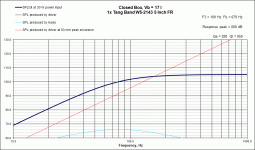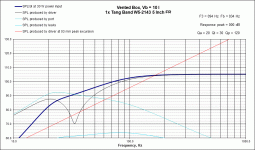Hello,
I was given two of these speakers, and after getting Unibox, I entered all the numbers from the data sheet. The micro-particle (or less) of speaker knowledge I have is of course enough to make all manner of mistakes, so I would be most grateful for any guidance you may wish to offer. It's easy to enter numbers, but I don't have the knowledge to interpret the graphs shown for closed and vented designs, or know whether to increase or decrease the box size. Based on the graphs, is a sealed design better? I do not want to damage the speakers; they are for desktop use with my computer, using an older, small receiver.
Thank you for your assistance.
Joe H.
I was given two of these speakers, and after getting Unibox, I entered all the numbers from the data sheet. The micro-particle (or less) of speaker knowledge I have is of course enough to make all manner of mistakes, so I would be most grateful for any guidance you may wish to offer. It's easy to enter numbers, but I don't have the knowledge to interpret the graphs shown for closed and vented designs, or know whether to increase or decrease the box size. Based on the graphs, is a sealed design better? I do not want to damage the speakers; they are for desktop use with my computer, using an older, small receiver.
Thank you for your assistance.
Joe H.
Attachments
Hi Joe,
For a sealed box, a lot of folks find a box size (Vb) that yields Qtc = .71 as the "optimum" size, but usually in the range of .60 to .80 gives an acceptable result. Check the resulting Fc and response curve.
Once you find the box sizes that give Qtc = .60 and .80, try those box values (Vb) for a ported box. And for port tuning frequency, try to keep Fb close to Fs (free air resonance). For example, this driver has Fs = 55 hz. Try Fb = 50, 55, and 60 Hz for the different values of Vb that you want to check out.
Run through some examples with your program (Unibox, for example). This should give you a good idea about how varying the box or port sizes will affect the response.
Hope this helps.
For a sealed box, a lot of folks find a box size (Vb) that yields Qtc = .71 as the "optimum" size, but usually in the range of .60 to .80 gives an acceptable result. Check the resulting Fc and response curve.
Once you find the box sizes that give Qtc = .60 and .80, try those box values (Vb) for a ported box. And for port tuning frequency, try to keep Fb close to Fs (free air resonance). For example, this driver has Fs = 55 hz. Try Fb = 50, 55, and 60 Hz for the different values of Vb that you want to check out.
Run through some examples with your program (Unibox, for example). This should give you a good idea about how varying the box or port sizes will affect the response.
Hope this helps.
Last edited:
- Status
- This old topic is closed. If you want to reopen this topic, contact a moderator using the "Report Post" button.

